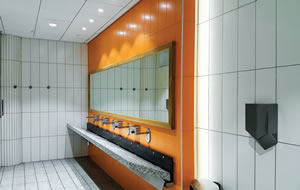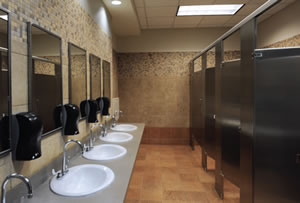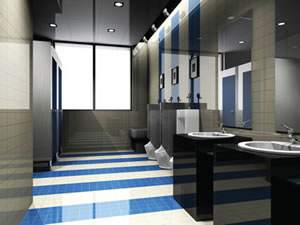Education Interiors
The Necessary Room
- By Amy Milshtein
- November 1st, 2016

PHOTO © KEELLLA
By now it's common knowledge that
colleges are upping their dorm room game.
Accommodations have become more homelike,
more luxurious and more attractive in the
race to attract and retain students. And that
sales pitch leans heavily on restrooms. Take
organizations like TriMark Properties, which
serves students from the University of Florida,
as example. They boast about their “shared or
private bathrooms” right on their homepage.
The move makes sense. “Higher education, in
particular, has shifted from bland institutional
washrooms designs to higher-end designs,” says
Will Haas, product manager, Bradley Corporation.
“Recruitment is the main driving factor in elevating
public restroom design in colleges and universities.
Administrators want their restrooms to look
top-notch and reflect innovation and forward-thinking
design — not dated-looking styles.”
But college restrooms are about more than
luxury. Hot-button issues include durability,
ease of maintenance and water conservation opportunities.
Here’s a look at what’s trending in
restroom design.
Water Works
Low-flow bathroom fixtures have been the
trend for a long time and for good reason. Less water
use means lower water bills and a better chance
of meeting LEED requirements. It’s also good public
relations. “Universities promote sustainability as a
means of attracting prospective students,” says Mike
Gipson, product line manager, Sloan.
Gipson points to a “variety of new and retrofit
products available to help achieve water conservation
goals.” He notes that manual flushometers
(the metal water diverter that uses an inline handle
to flush toilets or urinals) may be retrofitted with
dual-flush handles, “allowing the user to choose
between full or reduced flush options.”
There are also sensor-activated dual-flush
flushometers available as new or retrofit products.
These provided “automatic reduced flush based on
the amount of time the user is in range,” according
to Gipson. He notes that there is definitely a trend
towards lower gallons per flush. “1.28 gallons per
flush for toilets and 0.125 gallons per flush for urinals
are among the fastest-growing segments.”
Haas, from Bradley Corporation, offers a caveat.
“While the low-flow trend has been around for quite
some time now, we’re seeing that some facilities are
moving away from it largely because, at times, it
can wreak havoc on older plumbing systems, especially
with all the soap residue buildup in the pipes.”
Along with LEED, colleges and universities
are “also beginning to take note of product
transparency reports including Life Cycle Assessments
(LCA), Environmental Declarations
(EPD) and Health Product Declarations (HPD)
which are designed to provide information about
the full environmental impact of a product,” according
to Gipson.

PHOTO © MARTIN HAAS
Bottled Up
Each day in the U.S. more than 60 million
plastic water bottles are thrown away, according
to the Container Recycling Institute. Most end up
in landfills or incinerators while millions litter
America’s streets, parks and waterways. Of course,
the best way to keep water bottles out of the waste
stream is to not use them at all.
That’s the idea behind durable, reusable water
bottles. Schools will often give these logo-emblazoned
bottles away to students who are more than happy to fill and refill them. And that’s the problem. Refilling
tall water bottles on the go can be a hassle. In
answer, many schools are adding bottle filling stations
to their drinking fountains. “It’s not much
work to change out the water station,” reports Ellen
Sajdak, senior product manager, drinking water
products, Elkay, noting that the job can be done in
as little as half an hour.
The installation will take longer in buildings
with older, non-ADA-compliant vitreous china
water fountains. “That’s a bit more involved,”
says Sajdak, noting that new framing will need
to be added.
Far from set-it-and-forget-it, the unit comes
with a $125 filter that must be changed out for
every 3,000 gallons of water flow. “That’s about
22,000 16-ounce bottles worth of water,” says Sajdak.
“But not everyone needs a filter. Some cities
have great water.”
Air Dry or Scare Dry
Automatic hand dryers have been around for
decades and users have a love/hate relationship
with them. From a maintenance and facilities
standpoint, this technology has a lot going for it.
A white paper from World Dryer estimates that
the average person uses 2.5 paper towel sheets
every time they dry their hands. At two cents per
sheet, costs add up fast, even before factoring in
the labor it takes to restock dispensers and clean
up the inevitable mess of towels left behind.
Manufacturers have addressed other complaints
about the technology. Over the years, automatic
hand dryers have become faster, more powerful and
quieter. “At Dyson we spend $6.6 million a week
on research and development,” says Dyson Design
Engineer Anthony Hall. “A good portion of that is
concerned with making our existing products even
better.” The company has even come up with an all-in-one tap/hand dryer to eliminate water that often
accumulates on the floor under air dryers.
So why are people still reaching for paper towels?
Some are concerned that the air coming from
automatic hand dryers is dirty. Manufacturers
have addressed this with HEPA filters and antimicrobial
technology that inhibits the growth of bacteria, mold and fungus. “When the machine
is in use, as well as drying hands it’s effectively
acting as an air purifier, capturing airborne contaminants
in its filters,” insists Hall.

PHOTO © TANGYAN
But all of the advanced technology will not remove
the “ick” factor in public restrooms. People
don’t want to touch anything: toilet flushers, sink
taps or — heaven forbid — the exit door. Dan
Storto, president of World Dryer, suggests installing
a complimentary paper towel dispenser by the
exit door. “You would still see a significant reduction
in overall paper towel use,” he says. But mostly
he shakes his head at the notion. “We touch our
cell phones all the time and they’re quite dirty.”
Dyson’s Hall agrees. “I think that fixating on
the door handle is a bit of a distraction. As soon
as you enter a public washroom you’ll likely be
inhaling quite a few airborne particles and… we
generally live to see another day.”
Healthy Clean
After taking on the Nervous Nellies who are
afraid to touch any surface in a public restroom,
it’s time to admit that public restroom surfaces
can, in fact, be dangerous. MRSA, Hepatitis, E.
coli, flu and more lurk in restrooms and other
places around campus.
Proper cleaning will protect students,
faculty and staff from pathogens in restrooms.
Robert Richey, custodial supervisor, San Juan
College in Farmington, NM, explains in a
testimonial from Kaivac. “One of our goals
is to break the ‘circle of infection’ and protect
community health by continuously working
with and training staff in better methods
using the right equipment to foster hygienic
outcomes.”
This cleaning for health versus cleaning for
appearance mentality means focusing on “common
touch points.” In a restroom those touch
points include all parts of the toilet and urinals,
sink basin and handles, soap and towel dispensers
and, yes, door handles and push plates.
Cleaning these areas regularly will ensure
that your college restrooms look good because
they are good.
This article originally appeared in the November 2016 issue of College Planning & Management.